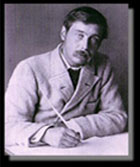

One of the greatest writers of all time
English novelist, journalist, sociologist, and historian, whose science-fiction stories have been filmed many times. Wells's best known books are THE TIME MACHINE (1895), THE INVISIBLE MAN (1897), and THE WAR OF THE WORLDS (1898). Wells wrote over a hundred of books, about fifty of them novels.
"No one would have believed, in the last years of the nineteenth century, that human affairs were being watched keenly and closely by intelligences greater than man's and yet as mortal as his own; that as men busied themselves about their affairs they were scrutinized and studied, parhaps almost as narrowly as a man with a microscope might scrutinize the transient creatures that swarm and multiply in a drop of water."
(from War of the Worlds)
Along with George Orwell's Nineteen-Eighty-Four and Aldous Huxley's Brave New World, which was an pessimistic answer to scientific optimism, Wells's novels are among the classical works of science-fiction, but his romantic and enthusiastic conception of technology later turned more doubtfull. His bitter side is seen early in the novel BOON (1915), which was a parody of Henry James.
H.G. Wells was born in Bromley, Kent. His father was a shopkeeper and a professional cricketer, and his mother served from time to time as a housekeeper at the nearby estate of Uppark. His father's business failed and to elevate the family to middle-class status, Wells was apprenticed like his brothers to a draper, spending the years between 1880 and 1883 in Windsor and Southsea. Later he recorded these years in KIPPS (1905). In the story Arthur Kipps is raised by his aunt and uncle. Kipps is also apprenticed to a draper. After learning that he has been left a fortune, Kipps enters the upper-class society, which Wells describes with sharp social criticism.
In 1883 Wells became a teacher/pupil at Midhurst Grammar Scool. He obtained a scholarship to the Normal School of Science in London and studied there biology under T.H. Huxley. However, his interest faltered and in 1887 he left without a degree. He taught in private schools for four years, not taking his B.S. degree until 1890. Next year he settled in London, married his cousin Isabel and continued his career as a teacher in a correspondence college. From 1893 Wells became a full-time writer.
After some years Wells left Isabel for one of his brightest students, Amy Catherine, whom he married in 1895. As a novelist Wells made his debut with The Time Machine, a parody of English class division and a satirical warning that human progress is not inevitable. The Time Traveller lands in the year 802701 and finds two people: the Eloi, weak and little, who live above ground, and the Morlocks, carnivorous creatures that live below ground. Much of the realism of the story was achieved by carefully studied technical details.
The basic principles of the machine contained materials regarding time as the fourth dimension - years later Albert Einstein published his theory of the four dimensional continuum of space-time. The work was followed by such science-fiction classics as THE ISLAND OF DR. MOREAU (1896), in which a mad scientist transforms animals into human creatures, The Invisible Man (1897), a Faustian story of a scientist who has tampered with nature in pursuit of superhuman powers, and The War of the Worlds (1898), a novel of an invasion of Martians. The story appeared at a time when Percival Lowell's "observations" of "canals" on Mars arose speculations that there could be life on the Red Planet. Inspite of the technological superiority of the Martians, their plan fails - they start to die off because they have no immunity to the bacteria of Earth. THE FIRST MEN ON THE MOON (1901) was prophetic description of the methodology of space flight, and THE WAR IN THE AIR (1908) was a hybrid that places Kipps-like Cockney hero in the context of a catastrophic aerial war.
Altough Wells's novels were highly entertaining, he also tried to pave way for a wiser attitude about the future of the mankind. Dissatisfied with his literary work, Wells moved into the novel genre, with LOVE AND MR. LEWISHAM (1900). He strenghtened his reputation as a serous writer with Kipps, TONO-BUNGAY (1909), and THE HISTORY OF MR. POLLY (1909), an ode to vanished England. He also published critical pamphlets attacking the Victorian social order, among them ANTICIPATIONS (1901), MANKIND IN THE MAKING (1903), and A MODERN UTOPIA (1905).
Passionate concern for society led Wells to join in 1903 the socialist Fabian Society in London, but he soon quarreled with the society's leaders, among them George Bernard Shaw. This experience was basis for his novel THE NEW MACHIAVELLI (1911), where he drew portraits of the noted Fabians. At the outbreak of war in 1914, Wells was involved in a love affair with the young English author Rebecca West, which influenced his work and life deeply.
"Nothing could have been more obvious to the people of the early twentieth century than the rapidity with which war was becoming impossible. And as certainly they did not see it. They did not see it until the atomic bombs burst in their fumbling hands."
(from The World Set Free, 1914)
After WW I Wells published several non-fiction works, among them THE OUTLINE OF HISTORY (1920), THE SCIENCE OF LIFE (1929-39), written in collaboration with Sir Julian Huxley and George Philip Wells, and EXPERIMENT IN AUTOBIOGRAPHY (1934). At this time Wells had gained the status as a popular celebrity, and he continued to write prolifically. In 1917 he was a member of Reserch Committee for the League of Nations and published several books about the world organization. In the early 1920s he was a labour candidate for Parliament. Between the years 1924 and 1933 Wells livend mainly in France. From 1934 to 1946 he was the International president of PEN. In 1934 he had discussions with both Stalin and Roosevelt, trying to recruit them to his world-saving schemes. However, he despaired of the whole business when the global war broke the peace for the second time. "The professional military mind is by necessity an inferior and unimaginative mind; no man of high intellectual quality would willingly imprison his gifts in such calling."
(from The Outline of History, 1920)
In THE HOLY TERROR (1939) Wells studied the psychological development of a modern dictator based on the careers of Stalin, Mussolini, and Hitler. In 1938 Orson Welles' Mercury Theater radio broadcast, based on The War of the Worlds, caused a panic which spread across the United States. Wells lived through World War II in his house on Regent's Park, refusing to let the blitz drive him out of London. His last book, MIND AT THE END OF ITS TETHER (1945), expressed pessimism about mankind's future prospects. Wells died in London on August 13. 1946.
All of the text and images used in the creation of this site were borrowed from various other web sites through out the internet for eductional purposes.
Created and Designed by Rstearns Graphics
